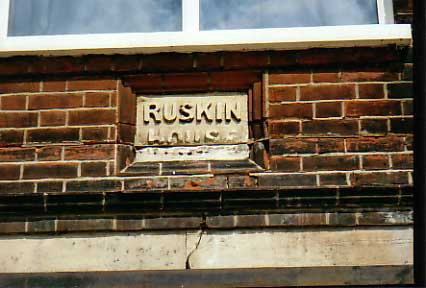
'Ruskin House', 95 Foxhall Road
Every picture tells a story. There once was a time, O Best Beloved, when every house and flat in a town the size of Ipswich was within walking distance of something called a "Post Office". This is where a wonderful invention by the Victorians whereby a service was provided for the whole population, whether you had a motorised jalopy or not, was situated. People bought stamps, drew their pensions, used GiroBank and everything. One such fine emporium stood on the corner of Foxhall Road and Ruskin Road until about 2006 and its extinction as a place of business revealed a classic piece of Lettering Vandalism.
In order to build the shop extension which used to front Foxhall Road, they cut the late Victorian brickwork right through the recessed panel bearing the name 'RUSKIN HOUSE' to accomodate the lead flashing. Now removed as part of its conversion into a dwelling, the butchered sign remains. (The lintel below doesn't look up to much, either.)
Residential roads in this area, part of the big eastern Ipswich housing development from the 1860s, often by the Ipswich & Suffolk Freehold Land Society (although not on this side of Foxhall Road), were given names around specific themes - a common practice. Hereabouts we find Faraday Road (scientist Michael Faraday, 1791-1867), Darwin Road (naturalist and geologist Charles Darwin, 1809-1882), Wellesley Road (Arthur Wellesley, 1st Duke of Wellington, 1769-1852), Gladstone Road (Liberal Prime Minister William Ewart Gladstone 1809-1898) and Henslow Road (geologist John Stevens Henslow, 1796-1861, mentor of Charles Darwin and second President of Ipswich Museum) among others: all notable Victorians. John Ruskin was born in London on 8 February 1819. He was one of the greatest figures of the Victorian age, poet, artist, critic, social revolutionary and conservationist. Ruskin's range was vast. He wrote over 250 works which started from art history, but expanded to cover topics ranging over science, geology, ornithology, literary criticism, the environmental effects of pollution, and mythology. After his death in 1900 Ruskin's works were collected together in a massive "library edition", completed in 1912 by his friends Edward Cook and Alexander Wedderburn. Its index is famously elaborate, attempting to articulate the complex interconnectedness of his thought. (See the Street name derivations page for further information.)
Here's a view of the former post office/shop in 2013.
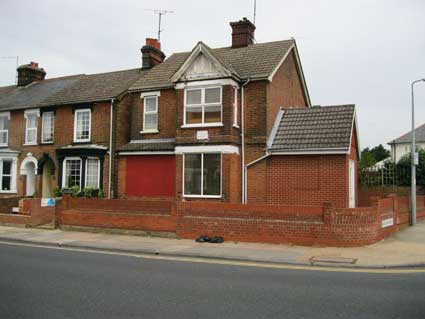 2013 images
2013 images
For houses named after eminent Victorians, see our Russell Villas page.
'Silver Dene', 91 Foxhall Road

[UPDATE 13.7.2024: 'I’m decorating my house next to the Ruskin House on Foxhall Road. Discovered house names below 5 layers and colours of paint. My house says "Silver Dene". My neighbour is also decorating and her house is right next to Ruskin House and hers, too, has a name. Hers is "Cambridge House". Oliver John.' Many thanks to Oli for spotting this fine – though faded – lettering, surviving on this attractive arch since late Victoian times.]
House numbering
Incidentally, if you have ever wondered about the way in which house numbering came about, our Named buildings list indicates that houses were usually known by a name only in early building of residential streets and roads (see the map of the Broom Hill area at the bottom of our brickyards page for examples named houses shown on an 1884 map). As populations and housing density increased it became unwieldy to rely on house names and probably strained the memories of postal deliverers. Numbering was an obvious solution, but where to start and how to accomodate numbering of later in-fill housing or newly-inserted roads? We learn that, with of plentiful, small, local post offices at a time when everyone communicated via the Royal Mail, numbering of roads – evens on one side, odds on the other – started from the nearest post office. The lowest numbered houses were nearest to this hub of the community, presumably because posties started their rounds there. Of course, there are always exceptions to the rule and quirks. Belle Vue Road displays a couple of examples of awkward numbering: the first house from the southern end on the left is number 17. At the northern end of the road the numbering jumps from 115 to 111. Can the number '113' be considered unlucky? Or was the number 113 allocated to the wedge-shaped plot currently occupied by a domestic garage? In the other direction, the Victorian 117 is followed by a modern house, 121. Number 119 is presumably allocated to the large, timber-built chaise house between the two which once belonged to the 1850 corner house, 'Fernside'. Elsewhere, we see infill houses given numbers such as 247a and 247b because there is no capacity in the existing numbering.
The Blooming Fuchsia
A short walk up Foxhall Road away from the town brings us to The Blooming Fuchsia at number 167, or rather the site of The Blooming Fuchsia on the corner of Foxhall Road and Fuchsia Lane.
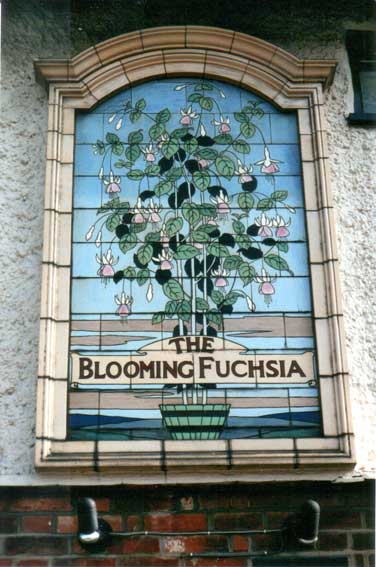 2002
image
2002
image
The superb 'pub sign' in coloured ceramic tile and relief surround announces
Doctor Fuchs and the Fuchsia plant and flower.
Father Charles Plumier, a Frenchman, was hunting for plants or trees which contained a chemical, later to be known as Quinine, to cure malaria; this probably happened during trips in the late 17th century, although dates are confused and Plumier's date of death is conjectural. He discovered a new genus of plant, calling it Fuchsia Triphylla Flora Coccinea. Fuchsia was named after a German man of medicine, Triphylla because it was three leafed (that, too, can be confusing: most fuchsia leaf nodes having two leaves), Flora for flower, and Coccinea for its scarlet colour (after the maroon cochineal dye extracted from a Mexican scale insect).
When it came to Plumier's naming of plants he liked to use a surname of respected personalities, for the Fuchsia, he thought of a German Doctor of Medicine who had died 80 years before Plumier was born. This Doctor was Leonhart Fuchs (1501-66), (Fox in English) who for most of his working life, worked at Tubingen University in charge of Medicine. He had written several books, including one called De Historia Stirpium, which contained 516 wood engravings and was (and still is) considered a masterpiece when it was published in Latin in 1542. However, the fact is Leonhart Fuchs, had nothing to do with the Fuchsia, other than have his name used by an admiring Frenchman, who remembered and respected him. Leonhart Fuchs is still well remembered for his work to the present day. Indeed 2001 saw celebrations of his 500th birthday throughout Europe.
Fuchsia cochineal, from Brazil is generally accepted as the first living plant to appear in Europe, probably in 1788 when a Captain Firth gave a plant to Kew Gardens. The 19th century saw British plant hunters lead the field with 25 out of 47 new species being found by the British. The countries where most of the fuchsia species were found, and can still be found, are Peru, Bolivia, Equador, Brazil, Columbia, Mexico, Chile, and other South American countries.

[UPDATE May, 2010: Oh dear. The Blooming Fuchsia was spotted being surrounded by shuttering. What will befall the famous sign? Demolition? UPDATE July, 2010: Having spotted a gentleman chipping away at the ceramic sign with hammer and chisel(!) in June, we enquired as to its fate and he replied that the sign would be going up again. We hope it wasn't damaged in the removal process. Now the Blooming Fuchsia building has disappeared.]
[UPDATE Spring 2011: The new flats are up on this site - for better or worse - and we thought all was lost, but a feature in the Property section of the Evening Star ( 6.5.11) which tried to sell/let the flats featured a photo of the ceramic sign, presumably round the back at the entrance.]
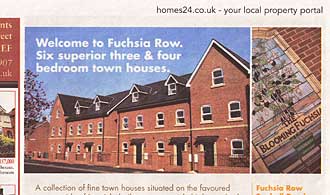
From the invaluable Suffolk CAMRA website (see Links) we learn:-
"A large single bar with an adjoining conservatory overlooking an enclosed garden. Finally closed its doors for the last time in late November 2009 after sporadic opening and closing over several years. The building has been demolished and replaced with six houses. Following a campaign by local Camra members, it's a condition of the planning permission that the unique tiled sign should be preserved and displayed on a wall of the development for as long as it stands. This was put back in place in April 2011. Originally only a beerhouse, first recorded in 1862; it was granted a full license in 1896. This was the only pub of this name in the entire country." All credit to those CAMRA campaigners.

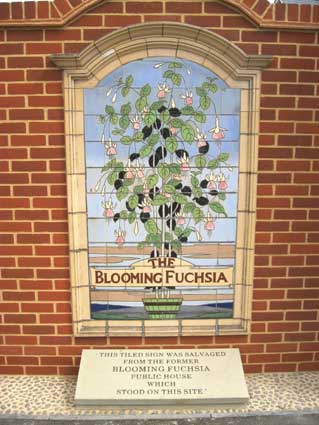
[UPDATE: Here it is, photographed in May 2011. The sign sits in a dedicated recess in the site's side wall in Fuchsia Lane with commemorative plaque beneath:

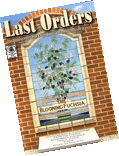
The Blooming Fuchsia sign was featured on the front cover (shown above) of the Suffolk and North Essex CAMRA magazine 'Last Orders' (Vol.34, Issue 3).
For a map showing the Blooming Fuchsia in 1902, see our Hope House page.
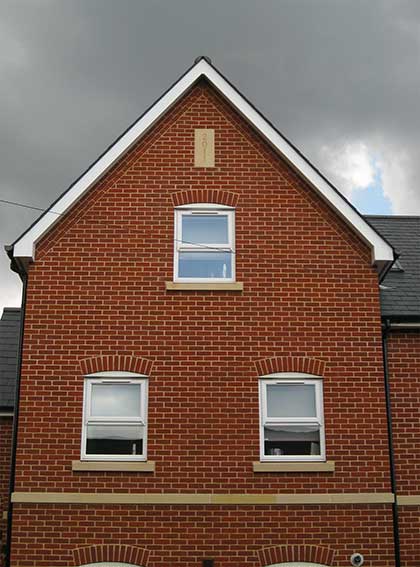 2014 image
2014 image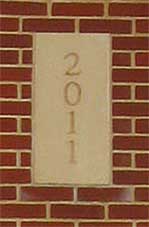
The 'Fuchsia Row' flats development fronting Foxhall Road carries a dated plaque '2011' in one of the gables (above number 2). It is interesting that, while commonplace in the Victorian and Edwardian eras (see our Dated buildings list), date plaques on housing do occasionally crop up in modern developments.
[UPDATE 30.7.2018: it was only in 2018 that we got round to photographing the crisp lettering cut into the stone band above ground floor level: 'FUCHSIA ROW']
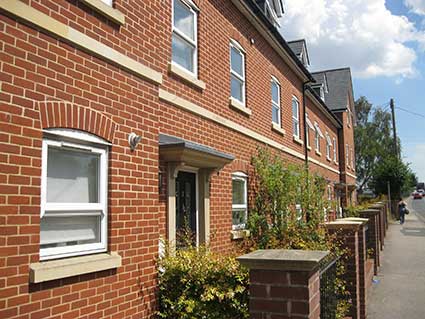
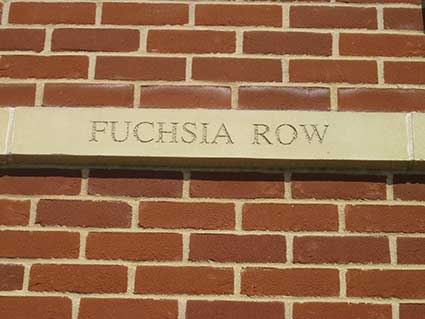 2018 images
2018 images
Landlords
[UPDATE 23.2.2014: 'Please find attached a scan of an original photographic postcard of the BLOOMING FUCHSIA, 167 Foxhall Road , Ipswich.
It is postally unused so I’m not sure of the exact date although it looks like it was commissioned to celebrate Edward W. Goodwin’s 30 years as the proprietor so possibly 1920's. You can see the ceramic tile sign on the side of the pub. Please feel free to add this image to your very informative website. Kind regards, Julian Gooding.']
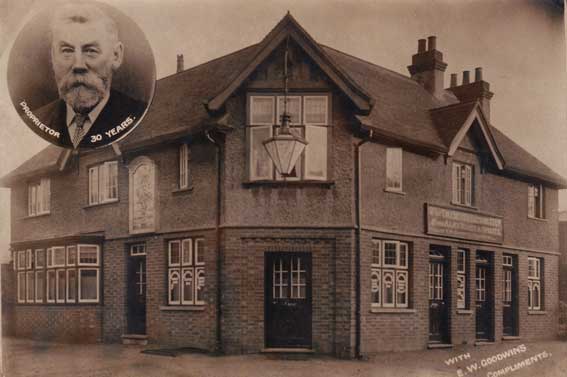 Image
courtesy Julian
Gooding
Image
courtesy Julian
Gooding
As well as the unique, tiled pub sign to the left (CAMRA can't find any other public house in the country with this name), we can see the signboard on the Foxhall Road elevation:
"1861 Richard Turner (Carpenter & Publican, Head/Married/26y/born Woodbridge)
1869 George Sterry (Beer retailer, pub not named) (Foxhall rd)
1871 + George A Sterry (Son/1/Ipswich)
1871 + George Sterry (Father, Widow/69y/Ipswich)
1871 + Sarah Ann Sterry (Wife/25/Ipswich)
1871 George Samuel Sterry (Shipwright/29y/Ipswich)
1888 Edward William Goodwin (beer retailer - pub not named) (Foxhall rd)
1891 Edward W Goodwin (Publican, Head/Married/50y/born Sotterley)
1891-1892 Edward Wm. Goodwin (beer house - pub not named) (Foxhall rd)
1900 Edward Goodwin
1901 Edward Goodwin (Publican, Head/Married/60y/born Sotterley)
1904 Edward William Goodwin
1911 Edward William Goodwin (Publican Licensed Victualler, Head/Widower/72y/born Sotterly)
1912 Edward William Goodwin
1916 Edward William Goodwin
1922 Edward William Goodwin
1932 Oliver Hy. Goodwin
1933 Oliver H Goodwin (Blooming Fuchsia PH - Foxhall rd)
1937 Oliver H Goodwin (Blooming Fuchsia PH - Foxhall rd)
1939 Oliver Hy. Goodwin
1952 Lawrence Stanley Ward
1956 Thos. W Leverett
Edward William Goodwin is known to have run the pub as early as (maybe earlier than) 1881. It took him many attempts (between 1881 and 1896) to obtain a full license for the then beerhouse." That would make the approximate date of the postcard 1918-1921 with the redoubtable Edward Goodwin still the licensee a year later. It looks as though his son took over after that.
Other public house lettering can be found at The Emperor in Norwich Road and in Needham Market. See also the Links list for the Brewery History Society website and archive of signs.
For another Foxhall Road signs see the Foxhall Road Co-op (now rebuilt).
See also the Pubs & Off-licences page and the Tolly Cobbold House & Brewery pages.
Fuchsia Lane
See also our Cavendish Street page for a large map detail from 1867, when much of the Rosehill Estate had yet to be developed by the Freehold Land Society, and Fuchsia Lane with hardly any buildings in it – and certainly no railway – is actually labelled 'BIRDS AVENUE', possibly named after a local landowner or market gardener. Presumably the lane was named after the public house?...
[UPDATE 27.2.2017: We hear that, contrary to the belief that the lane was named after the public house, the pub was itself named after a fuchsia nursery on or near the site. Suffolk is well-known for its enthusiasm for fuchsia-growing. See the Street name derivations page for more.]
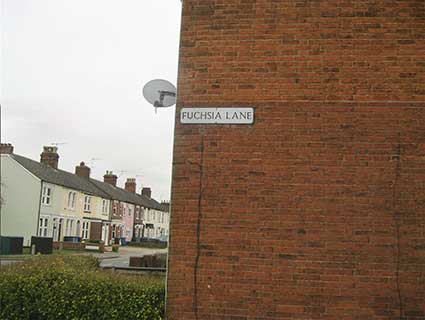 2018 images
2018 images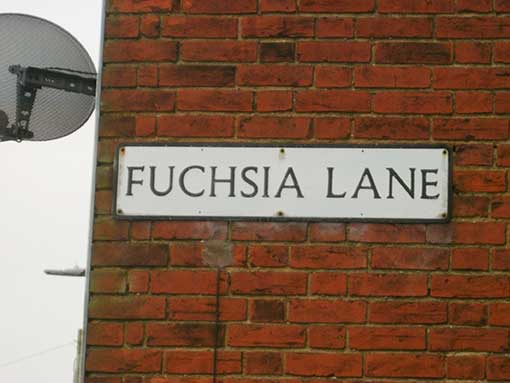
The other end of the lane is the site of a street nameplate (above, with Cauldwell Hall Road in the background) and a British Relay box, as shown and discussed on our Street furniture page.
Home
Please email any comments and contributions by clicking here.
Search Ipswich
Historic Lettering
©2004 Copyright throughout the Ipswich Historic Lettering site: Borin Van Loon
No reproduction of text or images without express written permission
Every picture tells a story. There once was a time, O Best Beloved, when every house and flat in a town the size of Ipswich was within walking distance of something called a "Post Office". This is where a wonderful invention by the Victorians whereby a service was provided for the whole population, whether you had a motorised jalopy or not, was situated. People bought stamps, drew their pensions, used GiroBank and everything. One such fine emporium stood on the corner of Foxhall Road and Ruskin Road until about 2006 and its extinction as a place of business revealed a classic piece of Lettering Vandalism.
In order to build the shop extension which used to front Foxhall Road, they cut the late Victorian brickwork right through the recessed panel bearing the name 'RUSKIN HOUSE' to accomodate the lead flashing. Now removed as part of its conversion into a dwelling, the butchered sign remains. (The lintel below doesn't look up to much, either.)
Residential roads in this area, part of the big eastern Ipswich housing development from the 1860s, often by the Ipswich & Suffolk Freehold Land Society (although not on this side of Foxhall Road), were given names around specific themes - a common practice. Hereabouts we find Faraday Road (scientist Michael Faraday, 1791-1867), Darwin Road (naturalist and geologist Charles Darwin, 1809-1882), Wellesley Road (Arthur Wellesley, 1st Duke of Wellington, 1769-1852), Gladstone Road (Liberal Prime Minister William Ewart Gladstone 1809-1898) and Henslow Road (geologist John Stevens Henslow, 1796-1861, mentor of Charles Darwin and second President of Ipswich Museum) among others: all notable Victorians. John Ruskin was born in London on 8 February 1819. He was one of the greatest figures of the Victorian age, poet, artist, critic, social revolutionary and conservationist. Ruskin's range was vast. He wrote over 250 works which started from art history, but expanded to cover topics ranging over science, geology, ornithology, literary criticism, the environmental effects of pollution, and mythology. After his death in 1900 Ruskin's works were collected together in a massive "library edition", completed in 1912 by his friends Edward Cook and Alexander Wedderburn. Its index is famously elaborate, attempting to articulate the complex interconnectedness of his thought. (See the Street name derivations page for further information.)
Here's a view of the former post office/shop in 2013.
 2013 images
2013 images
For houses named after eminent Victorians, see our Russell Villas page.
'Silver Dene', 91 Foxhall Road

[UPDATE 13.7.2024: 'I’m decorating my house next to the Ruskin House on Foxhall Road. Discovered house names below 5 layers and colours of paint. My house says "Silver Dene". My neighbour is also decorating and her house is right next to Ruskin House and hers, too, has a name. Hers is "Cambridge House". Oliver John.' Many thanks to Oli for spotting this fine – though faded – lettering, surviving on this attractive arch since late Victoian times.]
House numbering
Incidentally, if you have ever wondered about the way in which house numbering came about, our Named buildings list indicates that houses were usually known by a name only in early building of residential streets and roads (see the map of the Broom Hill area at the bottom of our brickyards page for examples named houses shown on an 1884 map). As populations and housing density increased it became unwieldy to rely on house names and probably strained the memories of postal deliverers. Numbering was an obvious solution, but where to start and how to accomodate numbering of later in-fill housing or newly-inserted roads? We learn that, with of plentiful, small, local post offices at a time when everyone communicated via the Royal Mail, numbering of roads – evens on one side, odds on the other – started from the nearest post office. The lowest numbered houses were nearest to this hub of the community, presumably because posties started their rounds there. Of course, there are always exceptions to the rule and quirks. Belle Vue Road displays a couple of examples of awkward numbering: the first house from the southern end on the left is number 17. At the northern end of the road the numbering jumps from 115 to 111. Can the number '113' be considered unlucky? Or was the number 113 allocated to the wedge-shaped plot currently occupied by a domestic garage? In the other direction, the Victorian 117 is followed by a modern house, 121. Number 119 is presumably allocated to the large, timber-built chaise house between the two which once belonged to the 1850 corner house, 'Fernside'. Elsewhere, we see infill houses given numbers such as 247a and 247b because there is no capacity in the existing numbering.
The Blooming Fuchsia
A short walk up Foxhall Road away from the town brings us to The Blooming Fuchsia at number 167, or rather the site of The Blooming Fuchsia on the corner of Foxhall Road and Fuchsia Lane.
 2002
image
2002
imageThe superb 'pub sign' in coloured ceramic tile and relief surround announces
'THE
BLOOMING FUCHSIA'
The definite article is tightly curved in a centred arc
above a cream scroll; the lettering in large and small caps).
Quite
who commissioned this work of art for such a modest building
(presumably
the brewers who owned the premises, The Colchester Brewing Company Ltd
– see the 1920s postcard below) deserves recognition. The fired
glazes
have ensured that the vibrant colours are as fresh today as they were
when
created. Noteworthy are the low landscape and the cloud formation
against a graduated pale ble sky behind the whole plant. Another
ceramic brewery sign exists on The
Butchers Arms in Knodishall.BLOOMING FUCHSIA'
Doctor Fuchs and the Fuchsia plant and flower.
Father Charles Plumier, a Frenchman, was hunting for plants or trees which contained a chemical, later to be known as Quinine, to cure malaria; this probably happened during trips in the late 17th century, although dates are confused and Plumier's date of death is conjectural. He discovered a new genus of plant, calling it Fuchsia Triphylla Flora Coccinea. Fuchsia was named after a German man of medicine, Triphylla because it was three leafed (that, too, can be confusing: most fuchsia leaf nodes having two leaves), Flora for flower, and Coccinea for its scarlet colour (after the maroon cochineal dye extracted from a Mexican scale insect).
When it came to Plumier's naming of plants he liked to use a surname of respected personalities, for the Fuchsia, he thought of a German Doctor of Medicine who had died 80 years before Plumier was born. This Doctor was Leonhart Fuchs (1501-66), (Fox in English) who for most of his working life, worked at Tubingen University in charge of Medicine. He had written several books, including one called De Historia Stirpium, which contained 516 wood engravings and was (and still is) considered a masterpiece when it was published in Latin in 1542. However, the fact is Leonhart Fuchs, had nothing to do with the Fuchsia, other than have his name used by an admiring Frenchman, who remembered and respected him. Leonhart Fuchs is still well remembered for his work to the present day. Indeed 2001 saw celebrations of his 500th birthday throughout Europe.
Fuchsia cochineal, from Brazil is generally accepted as the first living plant to appear in Europe, probably in 1788 when a Captain Firth gave a plant to Kew Gardens. The 19th century saw British plant hunters lead the field with 25 out of 47 new species being found by the British. The countries where most of the fuchsia species were found, and can still be found, are Peru, Bolivia, Equador, Brazil, Columbia, Mexico, Chile, and other South American countries.

[UPDATE May, 2010: Oh dear. The Blooming Fuchsia was spotted being surrounded by shuttering. What will befall the famous sign? Demolition? UPDATE July, 2010: Having spotted a gentleman chipping away at the ceramic sign with hammer and chisel(!) in June, we enquired as to its fate and he replied that the sign would be going up again. We hope it wasn't damaged in the removal process. Now the Blooming Fuchsia building has disappeared.]
[UPDATE Spring 2011: The new flats are up on this site - for better or worse - and we thought all was lost, but a feature in the Property section of the Evening Star ( 6.5.11) which tried to sell/let the flats featured a photo of the ceramic sign, presumably round the back at the entrance.]

From the invaluable Suffolk CAMRA website (see Links) we learn:-
"A large single bar with an adjoining conservatory overlooking an enclosed garden. Finally closed its doors for the last time in late November 2009 after sporadic opening and closing over several years. The building has been demolished and replaced with six houses. Following a campaign by local Camra members, it's a condition of the planning permission that the unique tiled sign should be preserved and displayed on a wall of the development for as long as it stands. This was put back in place in April 2011. Originally only a beerhouse, first recorded in 1862; it was granted a full license in 1896. This was the only pub of this name in the entire country." All credit to those CAMRA campaigners.


[UPDATE: Here it is, photographed in May 2011. The sign sits in a dedicated recess in the site's side wall in Fuchsia Lane with commemorative plaque beneath:
'THIS TILED SIGN WAS
SALVAGED
FROM THE FORMER
BLOOMING FUCHSIA
PUBLIC HOUSE
WHICH STOOD ON THIS SITE.'
FROM THE FORMER
BLOOMING FUCHSIA
PUBLIC HOUSE
WHICH STOOD ON THIS SITE.'
The access way to the
parking area behind the dwellings is just to the left of the sign. The
first thing that strikes the viewer, now that the sign is down at our
level, is how large it is. The colours and definition are both
excellent with a fine crazing visible in some of the enamels. Careful
study reveals that the two 'shoulder' tiles (shown below) on the second
row down have swapped places. The one on the right has a small piece of
greenery: this should be turned through 180 degrees and place on the
left side. The pure blue tile belongs on the right.]


The Blooming Fuchsia sign was featured on the front cover (shown above) of the Suffolk and North Essex CAMRA magazine 'Last Orders' (Vol.34, Issue 3).
For a map showing the Blooming Fuchsia in 1902, see our Hope House page.
 2014 image
2014 image
The 'Fuchsia Row' flats development fronting Foxhall Road carries a dated plaque '2011' in one of the gables (above number 2). It is interesting that, while commonplace in the Victorian and Edwardian eras (see our Dated buildings list), date plaques on housing do occasionally crop up in modern developments.
[UPDATE 30.7.2018: it was only in 2018 that we got round to photographing the crisp lettering cut into the stone band above ground floor level: 'FUCHSIA ROW']

 2018 images
2018 imagesLandlords
[UPDATE 23.2.2014: 'Please find attached a scan of an original photographic postcard of the BLOOMING FUCHSIA, 167 Foxhall Road , Ipswich.
It is postally unused so I’m not sure of the exact date although it looks like it was commissioned to celebrate Edward W. Goodwin’s 30 years as the proprietor so possibly 1920's. You can see the ceramic tile sign on the side of the pub. Please feel free to add this image to your very informative website. Kind regards, Julian Gooding.']
 Image
courtesy Julian
Gooding
Image
courtesy Julian
GoodingAs well as the unique, tiled pub sign to the left (CAMRA can't find any other public house in the country with this name), we can see the signboard on the Foxhall Road elevation:
'The COLCHESTER
BREWING CO.
LTD.
Fine ALES, WINES & SPIRITS.
E.W. GOODWIN Proprietor'
E.W. GOODWIN'S
COMPLIMENTS.'
Many thanks to Julian for this excellent image and
unusual celebration of one landlord. The invaluable Suffolk CAMRA site
(see Links) gives us the following
information:-Fine ALES, WINES & SPIRITS.
E.W. GOODWIN Proprietor'
You can see
the brewery premises of The Colchester
Brewing Co. Ltd on our Colchester page.
Additional lettering can be seen
on the windows and doors with 'The Blooming Fuchsia' diagonally on the
frosted glass facets of the large lantern above the corner door. In the
lower right corner:
'WITH E.W. GOODWIN'S
COMPLIMENTS.'
which indicates that, as happened
quite often, the photographer/card publisher provided the card to
enable Goodwin to promote his business.
"1861 Richard Turner (Carpenter & Publican, Head/Married/26y/born Woodbridge)
1869 George Sterry (Beer retailer, pub not named) (Foxhall rd)
1871 + George A Sterry (Son/1/Ipswich)
1871 + George Sterry (Father, Widow/69y/Ipswich)
1871 + Sarah Ann Sterry (Wife/25/Ipswich)
1871 George Samuel Sterry (Shipwright/29y/Ipswich)
1888 Edward William Goodwin (beer retailer - pub not named) (Foxhall rd)
1891 Edward W Goodwin (Publican, Head/Married/50y/born Sotterley)
1891-1892 Edward Wm. Goodwin (beer house - pub not named) (Foxhall rd)
1900 Edward Goodwin
1901 Edward Goodwin (Publican, Head/Married/60y/born Sotterley)
1904 Edward William Goodwin
1911 Edward William Goodwin (Publican Licensed Victualler, Head/Widower/72y/born Sotterly)
1912 Edward William Goodwin
1916 Edward William Goodwin
1922 Edward William Goodwin
1932 Oliver Hy. Goodwin
1933 Oliver H Goodwin (Blooming Fuchsia PH - Foxhall rd)
1937 Oliver H Goodwin (Blooming Fuchsia PH - Foxhall rd)
1939 Oliver Hy. Goodwin
1952 Lawrence Stanley Ward
1956 Thos. W Leverett
Edward William Goodwin is known to have run the pub as early as (maybe earlier than) 1881. It took him many attempts (between 1881 and 1896) to obtain a full license for the then beerhouse." That would make the approximate date of the postcard 1918-1921 with the redoubtable Edward Goodwin still the licensee a year later. It looks as though his son took over after that.
Other public house lettering can be found at The Emperor in Norwich Road and in Needham Market. See also the Links list for the Brewery History Society website and archive of signs.
For another Foxhall Road signs see the Foxhall Road Co-op (now rebuilt).
See also the Pubs & Off-licences page and the Tolly Cobbold House & Brewery pages.
Fuchsia Lane
See also our Cavendish Street page for a large map detail from 1867, when much of the Rosehill Estate had yet to be developed by the Freehold Land Society, and Fuchsia Lane with hardly any buildings in it – and certainly no railway – is actually labelled 'BIRDS AVENUE', possibly named after a local landowner or market gardener. Presumably the lane was named after the public house?...
[UPDATE 27.2.2017: We hear that, contrary to the belief that the lane was named after the public house, the pub was itself named after a fuchsia nursery on or near the site. Suffolk is well-known for its enthusiasm for fuchsia-growing. See the Street name derivations page for more.]
 2018 images
2018 images
The other end of the lane is the site of a street nameplate (above, with Cauldwell Hall Road in the background) and a British Relay box, as shown and discussed on our Street furniture page.
©2004 Copyright throughout the Ipswich Historic Lettering site: Borin Van Loon
No reproduction of text or images without express written permission